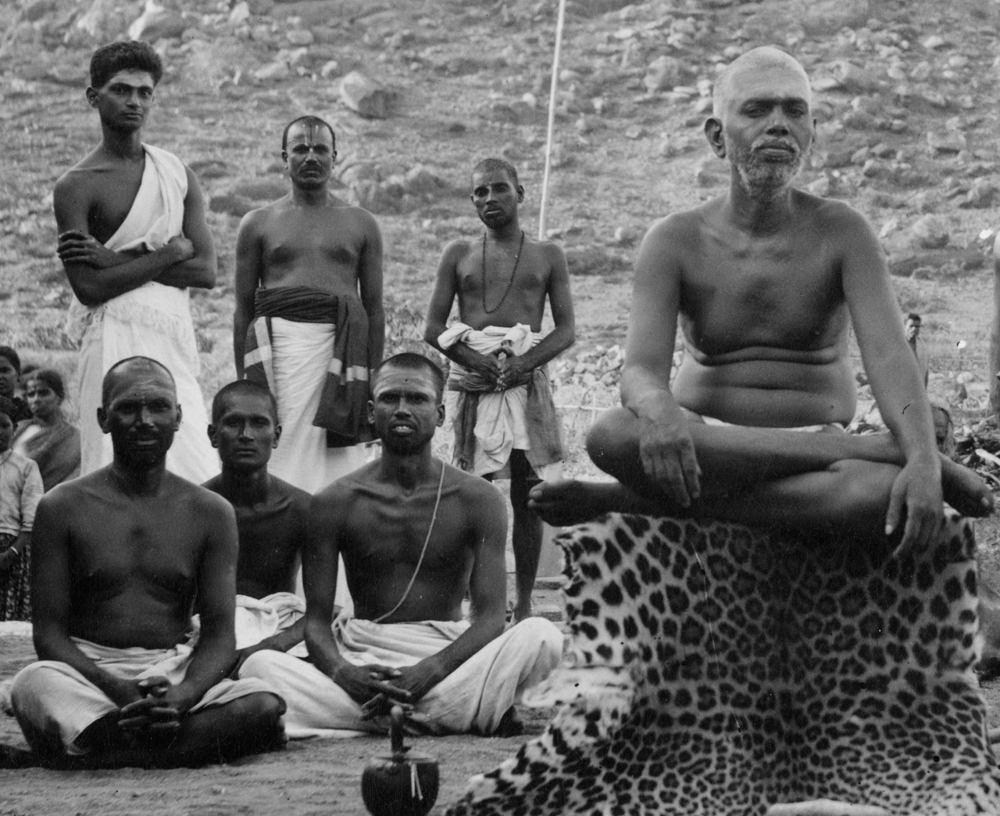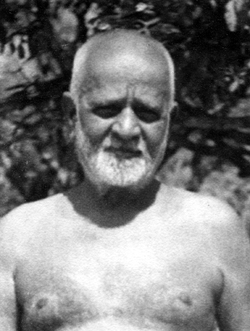
This article was first published in The Mountain Path, 1991, pp. 112-21. The original article contains additional annotations.
In the 1930s a devotee called Perumal Swami, who had managed Sri Ramanashram prior to 1922, instigated a court case against Ramana Maharshi and his brother Chinnaswami. The latter had taken over the management of the ashram around 1928. Perumal Swami claimed in his submission to the court that he was still the legitimate manager of Sri Ramanasramam and attempted to support his case with some rather convoluted logic. Firstly, he declared that since Bhagavan was a sannyasin, he could not legally own land or property. This being so, Perumal Swami argued, Bhagavan had no rights over the property known as Sri Ramanashram. Perumal Swami then went on to argue that since Bhagavan could not own any of the ashram’s property, he had no authority to appoint his brother to manage it. He then advanced his own case by saying that since he had been the undisputed manager at Skandashram, where Bhagavan had lived from 1916-22, he must still be the ashram manager because neither Ramana Maharshi nor anyone else was legally competent to remove or replace him.

Perumal Swami’s complaint to the court conveniently ignored two important points:
1 Bhagavan had never claimed that he was a sannyasin. Since he had never been formally initiated into any order of sannyasins, he was still entitled to own and dispose of property.
2 Perumal Swami had voluntarily relinquished the job of ashram manager in 1922. Since that date he had neither lived in the ashram nor taken any part in its management.
Under Indian law, the formal adoption of sannyasa means that the sannyasin can be legally regarded as being dead. He loses all rights to his property, which is taken over by his appointed heirs. If he belongs to some of the traditional orders of sannyasa, he has no rights to own or acquire property again. In order to refute Perumal Swami’s case, Bhagavan had to demonstrate that he belonged to an asrama (that is, an accepted ‘stage of life’) that permitted its members to own property. In sannyasa, the fourth asrama, owning property is prohibited, but members of the other three asramas (brahmacharya, grihastha and vanaprastha) face no such restriction. However, instead of taking the easy course and declaring himself to be either in the grihastha (householder) or vanaprastha (meditating hermit) asrama, he declared that he was in atiasrama, which means ‘beyond all asramas‘. This category is so little-known, even in India, during his first encounter with Perumal Swami’s lawyer he was asked to define the state and certify that it was backed by some scriptural authority.
Question: To which asrama does Bhagavan belong?
Bhagavan: Atiasrama.
Q: What is it?
B: It is beyond the four commonly known asramas.
Q: Is it sastraic?
B: Yes, it is mentioned in the sastras. (Talks with Sri Ramana Maharshi, talk no. 281)

This account in Talks was written down from memory by Munagala Venkataramaiah, its compiler. A court stenographer also took down everything that Bhagavan said verbatim and the ashram’s lawyer, T. P. Ramachandra Iyer, later made a copy of these answers for the ashram records. This copy, which has been preserved by the President of Sri Ramanasramam, contains many interesting additional remarks that are not to be found in the Talks account.
Bhagavan began his testimony by talking about his early life and how he came to Tiruvannamalai. Since he had already seen Perumal Swami’s complaint, Bhagavan knew that the court would want him to state which asrama he belonged to. He therefore began his remarks in the following way:
I am of brahmin birth. When I came to this place I was seventeen years old. My upanayana [the brahmin thread ceremony] had taken place even before I came here. When I came to this place I had been living among people who were in the grihastha asrama. Within an hour of coming to this town I threw away my sacred thread and then had my head shaved. I arrived here with approximately three rupees. I threw away that money also.
In throwing away his thread he renounced his caste and in shaving his head he indicated that he had embarked on a life of physical renunciation without taking the formal step of adopting sannyasa.
After giving a few more details about his early life, he gave three answers that were partially recorded in the dialogue given above:
I remain in atiasrama, that is, not attached to anything in life.
Atiasrama is in the sastras.
I do not know of anyone else who is remaining in this asrama.
These answers were given on 15th November, 1936. A few weeks later, on 5th December, Perumal Swami’s lawyer continued his cross-examination. This is the version recorded in Talks :
Question: You spoke of atiasrama the other day. Is there authority for it? Is it mentioned anywhere?
Bhagavan: Yes, in the Upanishads, the Suta Samhita [Skanda Purana], Bhagavata, Bharata and other works.
Q: Are there any restrictions or disciplines for that state?
B: There are characteristics of it mentioned.
Q: There are Gurus for each asrama. Is there a Guru for atiasrama?
B: Yes.
Q: But you do not admit a Guru.
B: There is a Guru for everyone. I admit a Guru for me also.
Q: Who is your Guru?
B: The Self.
Q: For whom?
B: For myself. The Guru may be internal or external. He may reveal himself internally or externally.
Q: Can the atiasrami own property?
B: There is no restriction for them. They may do what they please. Suka is said to have married and begotten children also.
Q: The atiasrami is like a householder in that case.
B: I have already said that he is above the four recognised asramas.
Q: If they can marry, own property etc., they are only grihasthas.
B: That may be your view.
Q: Can they own property and convey the same to others?
B: They may or may not. It depends on their prarabdha [destiny].
Q: Is there any karma for them?
B: Their conduct is not regulated according to rules or codes. (Talks with Sri Ramana Maharshi, talk no. 281)
The official court transcript that covers this part of the cross-examination contains a number of significant details that are not recorded in Talks. Only Bhagavan’s answers appear in T. P. R.’s copy of the court document, but when these answers are correlated with the answers in Talks, the aim and scope of the questions can easily be inferred. The answers were:
Details about atiasrama are contained in the Suta Samhita.
The injunctions about atiasrama are set out in this work.
If those who are in atiasrama need property, they are entitled to possess it.
For any asrama a Guru is needed.
A Guru is necessary even for those who are in atiasrama.
For me Atma itself is the Guru. My Atma is Guru for my Atma.
I have read in the Puranas that those who followed atiasrama owned property.
These things are described in Suta Samhita, that is to say, in the Skanda Purana.
In atiasrama one can declare, ‘This is my property’.
It has been declared that those who are in the state of atiasrama can dispose of their property to other people.
Whether grihastha and atiasrama are the same depends on the view of the man who is looking.
For those who remain in atiasrama, there is no need to perform nitya karmas [daily rituals].
The court transcript reveals more clearly than the Talks account that the case was a property dispute and that its resolution hinged on whether or not Bhagavan could own and dispose of property. Bhagavan’s claim that he could own property because he was an atiasrami was an unusual one, but he supported his claim by citing the Suta Samhita. The Suta Samhita, which is part of the Skanda Purana, is little read nowadays, but in ancient times it had enormous authority and influence. In an introduction to an edition of this work that Bhagavan kept for reference the editor notes that there is a tradition that Adi-Sankaracharya read the Suta Samhita eighteen times before he began work on his famous commentaries.
There are four verses in the Siva Mahatmya Khanda, one of the sub-divisions of the Suta Samhita, which back up Bhagavan’s claim that one who has realised the Self has transcended all castes and asramas and is therefore not subject to any restriction such as asrama dharmas, the rules that members of each asrama have to abide by.
A person who has attained true knowledge [aparoksha vijnana] with the help of the vedantic vakyas [the four mahavakyas or great sayings of the Upanishads], and who experiences the Atma which is full of bliss, is not subject to any restrictions.
For the people who belong to castes, elaborate asrama dharmas [codes of behaviour for each of the stages of life] have been laid down by eminent persons well versed in the sastras. These rules are always compulsory for those people who have a caste and an asrama.
The caste and asrama dharmas do not bind those, either male or female, who have attained clear knowledge of Brahman.
If a person abandons his caste and asrama without realising the inherent knowledge of the Atma, his fall is certain.
Although Bhagavan regularly cited the Suta Samhita when he was asked to produce some scriptural authority for the state of atiasrama, it cannot be said that he endorsed the second and fourth of these verses from the Siva Mahatmya Khanda in which it is stated that those who have not realised the Self should adhere at all times to their caste and asrama rules. During the Veda parayana, for example, which was conducted in his presence every day, Bhagavan allowed all visitors and devotees to attend, saying that it was conducive to meditation. This was a flagrant violation of caste rules since traditionally only the higher castes are supposed to listen to such chants. Bhagavan encouraged devotees to break this rule and refused to pay any attention to the complaints of the traditionalists who pointed out that he was deliberately flouting caste and asrama (varnasrama) rules. On one occasion, when a North Indian visitor challenged Bhagavan on this matter, Bhagavan curtly told him to sit down and mind his own business. (The Mountain Path, 1968, p. 72.)
In the dining room Bhagavan did not object if brahmins decided to eat with the non-brahmins (a very basic violation of varnasrama dharma) so long as it was their custom to do so in other places as well. But if they observed caste eating rules at home, Bhagavan would often insist that they continue to observe such rules in the ashram. Bhagavan did not want the ashram to be used as a platform for visitors who wanted to make political or sociological gestures. His often-repeated phrase, ‘Attend to what you came here for,’ was frequently directed at visitors who forgot to leave their politics and their opinions at home.